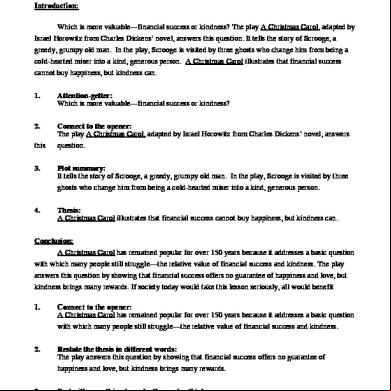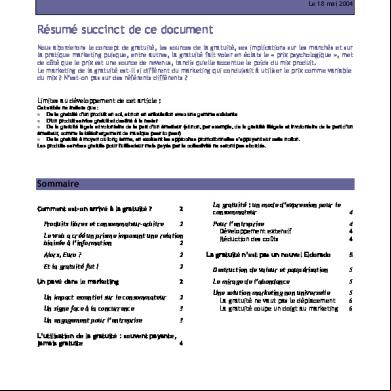Evolution Of Cbis 5l2p2y
This document was ed by and they confirmed that they have the permission to share it. If you are author or own the copyright of this book, please report to us by using this report form. Report 3b7i
Overview 3e4r5l
& View Evolution Of Cbis as PDF for free.
More details w3441
- Words: 884
- Pages: 34
MANAGEMENT INFORMATION SYSTEMS
Chapter 1 Introduction to the Computer-Based Information System
1-1
Information Management
Information: The most valuable resource
1-2
Five Main Resources Personnel Material Machines – (including facilities and energy)
Money Information (and data)
}
}
Physical
Conceptual
1-3
How Resources are Managed Acquire Assemble, or prepare Maximize use Replace
1-4
Factors Stimulating Interest in Information Management Increasing complexity of business activity – – – – –
International economy Worldwide competition Increasing complexity of technology Shrinking time frames Social constraints
Improved computer capabilities – Size – Speed
1-5
Who are the s? Managers Nonmanagers Persons & organizations in the firm’s environment
1-6
The Influence of Management Level on Information Source Strategic planning level
Environmental
Management control level Operational control level
Internal
1-7
The Influence of Management Level on Information Form Strategic planning level
Summary
Management control level Operational control level
Detail
1-8
Managers Can Be Found on All Levels and in All Functional Areas of the Firm Strategic planning level Management Control Level Operational Control Level Finance Function
Human Resources Function
Information Services Function
Manufacturing Function
Marketing Function 1-9
What Managers do -Fayol’s Functions Strategic
Management
Operational
Planning Level
Control Level
Control Level
Plan Direct Staff
Organize Control
Plan Control
Organize
Control
Direct
Staff
Direct
Organize
Staff Plan
1-10
What Managers do -Mintzberg’s Roles Interpersonal roles Decisional roles – Figurehead – Leader – Liaison
Informational roles – Monitor – Disseminator – Spokesperson
– Entrepreneur – Disturbance handler – Resource allocator – Negotiator
1-11
Management Skills Communications Problem solving
}
How can an information specialist help?
1-12
Problem Solving Information Comes in Many Forms External Sources Internal Sources
Oral Media Written Media
Business Meals Tours Voice Mail Telephone Unscheduled Meetings
Scheduled Meetings
Periodicals Electronic mail Letters & Memos Noncomputer reports
Computer Reports
1-13
Problem Solving
Management Knowledge Computer literacy Information literacy What’s the difference?
1-14
System Components Component parts of a system that can control its own operations Objectives
Control mechanism
Input
Transformation
Output 1-15
Open-Loop System
Input
Transformation
Output
1-16
Open versus Closed Systems Open system – Connected to its environment by means of resource flows
Closed system – Not connected to its environment
1-17
Systems
Can Be Composed of Subsystems or Elemental Parts
System Subsystem A
Subsystem B
Subsystem A-1
Subsystem B-1
Subsystem A-2
Subsystem B-2
Subsystem A-3
Elemental part B1
Elemental Part C
1-18
Physical and Conceptual Systems Physical system – The business firm – Composed of physical resources
Conceptual system – Represents a physical system – Uses conceptual resources » Information » Data 1-19
A Systems View Business operations are embedded within a larger environmental setting – – – – –
Reduces complexity Requires good objectives Emphasizes working together Acknowledges interconnections Values
1-20
Data and Information Information processor – – – –
Key element in the conceptual system Computer Noncomputer Combination
Data is the raw material transformed into information 1-21
Evolution of the CBIS Data Processing (DP) Management Information Systems (MIS) 1964 – IBM promoted the concept as a means of selling disk files and terminals
Decision Systems (DSS) 1971 – Text book’s distinction: » MIS: Organizational/group - general » DSS: Individual - specific
Office Automation (OA) 1964 Artificial Intelligence (AI)/ Expert Systems (ES) - 1990s – Heavy investment by businesses
1-22
The CBIS Model Computer-based Information System
(CBIS) ing Information System
Problem
Decisions
Information
Management Information System Decision Systems
Problem Solution
The Virtual Office Knowledge-based Systems
1-23
Information Services Information specialists have full-time responsibility for developing and maintaining computer-based systems
1-24
Traditional Communication Chain Database
Systems Analyst
Programmer
Operator
Computer
Network Specialist
1-25
End- Computing (EUC) End- computing – Development of all or part of applications – Information specialists act as consultants
Stimulants to EUC – – – –
Increased computer literacy IS backlog Low-cost hardware (the PC) Prewritten software (electronic spreadsheets) 1-26
IS and EUC The End- Computing Communication Chain Information Specialists
Communication
Computer 1-27
Justifying the CBIS Justify in the same manner as any other large investment Economic – Cost reduction – Reduced inventory investment – Increased productivity (CAD/CAM)
Noneconomic – Perceived value 1-28
Achieving the CBIS
1-29
Reengineering the CBIS Business Process Reengineering (BPR) – Reworking systems – Good system features retained – Becoming development methodology of choice
1-30
Roles Played by the Manager and by the Information Specialist Phase Manager Information Specialist Planning
Define problem
Analysis
Control
Design
Control
Implementation
Control
Implement system
Use
Control
Make available
System Study Design system
1-31
Summary Information is one of five main resources Computer output used by managers and nonmanagers A system is an integration of elements working toward an objective – Physical – Conceptual
Data vs. Information 1-32
Summary [cont.] CBIS composed of various components – – – – –
AIS MIS DSS Virtual office Knowledge-based systems
End- computing trends CBIS development 1-33
Topik Presentasi Human Resource Information System Financial Information System Manufacturing Information System ing Information System Marketing Information System Management Information System Decision System Enterprise Information System Executive Information System
Chapter 1 Introduction to the Computer-Based Information System
1-1
Information Management
Information: The most valuable resource
1-2
Five Main Resources Personnel Material Machines – (including facilities and energy)
Money Information (and data)
}
}
Physical
Conceptual
1-3
How Resources are Managed Acquire Assemble, or prepare Maximize use Replace
1-4
Factors Stimulating Interest in Information Management Increasing complexity of business activity – – – – –
International economy Worldwide competition Increasing complexity of technology Shrinking time frames Social constraints
Improved computer capabilities – Size – Speed
1-5
Who are the s? Managers Nonmanagers Persons & organizations in the firm’s environment
1-6
The Influence of Management Level on Information Source Strategic planning level
Environmental
Management control level Operational control level
Internal
1-7
The Influence of Management Level on Information Form Strategic planning level
Summary
Management control level Operational control level
Detail
1-8
Managers Can Be Found on All Levels and in All Functional Areas of the Firm Strategic planning level Management Control Level Operational Control Level Finance Function
Human Resources Function
Information Services Function
Manufacturing Function
Marketing Function 1-9
What Managers do -Fayol’s Functions Strategic
Management
Operational
Planning Level
Control Level
Control Level
Plan Direct Staff
Organize Control
Plan Control
Organize
Control
Direct
Staff
Direct
Organize
Staff Plan
1-10
What Managers do -Mintzberg’s Roles Interpersonal roles Decisional roles – Figurehead – Leader – Liaison
Informational roles – Monitor – Disseminator – Spokesperson
– Entrepreneur – Disturbance handler – Resource allocator – Negotiator
1-11
Management Skills Communications Problem solving
}
How can an information specialist help?
1-12
Problem Solving Information Comes in Many Forms External Sources Internal Sources
Oral Media Written Media
Business Meals Tours Voice Mail Telephone Unscheduled Meetings
Scheduled Meetings
Periodicals Electronic mail Letters & Memos Noncomputer reports
Computer Reports
1-13
Problem Solving
Management Knowledge Computer literacy Information literacy What’s the difference?
1-14
System Components Component parts of a system that can control its own operations Objectives
Control mechanism
Input
Transformation
Output 1-15
Open-Loop System
Input
Transformation
Output
1-16
Open versus Closed Systems Open system – Connected to its environment by means of resource flows
Closed system – Not connected to its environment
1-17
Systems
Can Be Composed of Subsystems or Elemental Parts
System Subsystem A
Subsystem B
Subsystem A-1
Subsystem B-1
Subsystem A-2
Subsystem B-2
Subsystem A-3
Elemental part B1
Elemental Part C
1-18
Physical and Conceptual Systems Physical system – The business firm – Composed of physical resources
Conceptual system – Represents a physical system – Uses conceptual resources » Information » Data 1-19
A Systems View Business operations are embedded within a larger environmental setting – – – – –
Reduces complexity Requires good objectives Emphasizes working together Acknowledges interconnections Values
1-20
Data and Information Information processor – – – –
Key element in the conceptual system Computer Noncomputer Combination
Data is the raw material transformed into information 1-21
Evolution of the CBIS Data Processing (DP) Management Information Systems (MIS) 1964 – IBM promoted the concept as a means of selling disk files and terminals
Decision Systems (DSS) 1971 – Text book’s distinction: » MIS: Organizational/group - general » DSS: Individual - specific
Office Automation (OA) 1964 Artificial Intelligence (AI)/ Expert Systems (ES) - 1990s – Heavy investment by businesses
1-22
The CBIS Model Computer-based Information System
(CBIS) ing Information System
Problem
Decisions
Information
Management Information System Decision Systems
Problem Solution
The Virtual Office Knowledge-based Systems
1-23
Information Services Information specialists have full-time responsibility for developing and maintaining computer-based systems
1-24
Traditional Communication Chain Database
Systems Analyst
Programmer
Operator
Computer
Network Specialist
1-25
End- Computing (EUC) End- computing – Development of all or part of applications – Information specialists act as consultants
Stimulants to EUC – – – –
Increased computer literacy IS backlog Low-cost hardware (the PC) Prewritten software (electronic spreadsheets) 1-26
IS and EUC The End- Computing Communication Chain Information Specialists
Communication
Computer 1-27
Justifying the CBIS Justify in the same manner as any other large investment Economic – Cost reduction – Reduced inventory investment – Increased productivity (CAD/CAM)
Noneconomic – Perceived value 1-28
Achieving the CBIS
1-29
Reengineering the CBIS Business Process Reengineering (BPR) – Reworking systems – Good system features retained – Becoming development methodology of choice
1-30
Roles Played by the Manager and by the Information Specialist Phase Manager Information Specialist Planning
Define problem
Analysis
Control
Design
Control
Implementation
Control
Implement system
Use
Control
Make available
System Study Design system
1-31
Summary Information is one of five main resources Computer output used by managers and nonmanagers A system is an integration of elements working toward an objective – Physical – Conceptual
Data vs. Information 1-32
Summary [cont.] CBIS composed of various components – – – – –
AIS MIS DSS Virtual office Knowledge-based systems
End- computing trends CBIS development 1-33
Topik Presentasi Human Resource Information System Financial Information System Manufacturing Information System ing Information System Marketing Information System Management Information System Decision System Enterprise Information System Executive Information System










